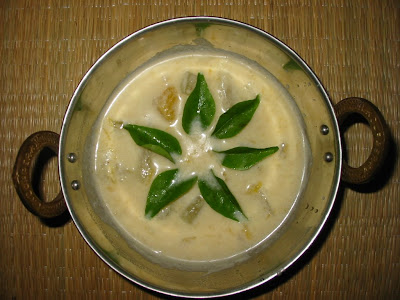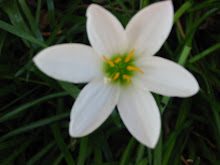Tuesday, June 30, 2009
Olan
Posted by Roopashree Srinath at 2:57 AM 1 comments
Labels: Gojjus and Stews
Pepper Rasam
Posted by Roopashree Srinath at 2:30 AM 0 comments
Labels: Rasam Varieties
Sunday, June 28, 2009
Sambar for Idlis
The given recipe for sambar is mainly used as an accompaniment for idli, dosa, pongal etc. This recipe comes very close in taste to the sambar served in hotels in Bengalooru. A friend got this recipe from a hotelier.
Ingredients:
1 cup Toor dal/Togaribele.
2-3 medium sized onions or 18-20 pearl onions.
2 large tomatoes.
Lemon sized Tamarind - prepare the pulp.
Salt to taste.
For the masala:
2 tablespoons Channadal.
1-1/2 tablespoon Coriander seeds.
3/4 teaspoon Fenugreek seeds/Methi.
5-6 Red chillies.
1 teaspoon Cumin seeds.
1/2 teaspoon Pepper.
2 teaspoons Poppy seeds/Khas khas/Gasagase.
A small piece of Cinnamon/Dalchini/Patte.
Pinch of Asafoetida or hing.
Dry fry all of these spices till they give a good aroma. Add 4 tablespoons of fresh/frozen coconut. Grind into a paste.
Method:
Thoroughly wash the dal and pressure cook the same with a 1/4 teaspoon of turmeric. Add the chopped onions and tomatoes to the cooked dal and let them cook well. Once the vegetables are cooked, add salt and tamarind pulp and let cook for 5-6 minutes. A little jaggery may be added optionally. Hotel sambar in Bengaloooru is sweet in taste and watery. Adjust the consistency according to your liking by adding water. Now add the ground masala and let it boil till everything blends well. This may take 10-12 minutes. Finally, season mustard seeds, curry leaves, and asafoetida in oil and add to the sambar. Garnish with finely cut coriander leaves.
Enjoy with hot idlis.
Posted by Roopashree Srinath at 8:22 AM 0 comments
Labels: Sambar Varieties
Friday, June 26, 2009
Supersoft Idlis with Sambar
Ingredients:
1 cup urad dal.
3 cups Par boiled rice/Kusubalakki.
1 cup regular rice(sona masoori)/ootada akki.
Method:
- Wash both the varieties of rice thoroughly and soak them together for 4-5 hours.
- Wash the urad dal thoroughly and soak it in water for 2 hours.
- First grind the urad dal in the grinder till very smooth and fluffy. Add water gradually and intermittently to get a light and fluffy texture.
- Now grind the soaked rice (remove the excess water used for soaking) into a fine rawa texture. It should be neither too coarse nor too smooth. Add water as required gradually.
- Add the urad dal batter and salt to the ground rice mixture and run the grinder for 1 minute to ensure that both the batters and salt are mixed well.
- Now tranfer the contents into a large vessel so that there is enough room for the batter to rise.
- Allow it to ferment overnight.
- Next morning, mix the batter well and pour into greased idli plates and steam cook in a pressure cooker for 15 minutes.
- Once the idlis are done, remove them from the moulds carefully with the help of a flat spoon and serve them hot with ghee and sambar or chutney.
For the recipe for sambar, please refer to the entry "Sambar for idlis".
Variation: Instead of soaking and grinding rice, rice rawa can be used to prepare idlis. Soak the rice rawa in luke warm water just as you start grinding the urad dal. Once the urad dal is ground, drain all the water from the rice rawa, squeeze out well in your hands and add it to the smoothly ground urad dal batter. Add salt allow to ferment and make soft idlis the next morning. Use 2-1/2 cups of rice rawa for 1 cup of urad dal.
Posted by Roopashree Srinath at 1:16 AM 2 comments
Labels: Breakfast
Tuesday, June 23, 2009
Bisi Bele Bhath
This is the crowning glory of Kannada cooking. It is a combination of rice and lentils with loads of vegetables, all combined into a divine dish with the help of an exotic spice powder. The speciality of this dish is the delicateness of its taste enhanced by a variety of Indian spices that are used very subtly. There is no overbearing taste of any particular spice.
Ingredients for the Spice powder:
1-1/2 cups Channa dal (Bengal gram).
1 cup Urad dal (Black gram).
2 cups Coriander seeds.
12-15 Red chillies (can be adjusted according to one’s tolerance).
1 teaspoon Fenugreek seeds/ Methi.
3/4 teaspoon Cumin seeds /Jeera.
2 teaspoons Poppy seeds/Khas khas/Gasagase.
1 inch piece of the mild variety of Cinnamon bark available in India. If using the US variety, use half the quantity.
3-4 peels of Cardamom (without the seeds).
To be roasted/warmed separately:
1 to 1-1/2 cup Grated dry copra.
Pinch of nutmeg(jaiphal/jaakai) and mace(jaivitri/jaapathre).
- Dry roast the above ingredients one by one preferably in the same order as given above.
- Switch off the stove, transfer the contents to a plate to let cool. Now add copra, nutmeg and jaadi pathre to the frying pan. These ingredients will get warm and crisp because of the heat of the pan and that will suffice.
- Grind everything(except copra, nutmeg and mace into a smooth powder. It need not be very fine, can be a little coarse, but not too coarse.
- Now separately grind the copra, nutmeg and mace and set aside.
Ingredients for the dish:
1 cup of Toor dal/Togaribele.
1-1/4 cup good quality rice.
1 to 1-1/2 cup Spice powder – can be adjusted according to requirement.
Tamarind -size of a big lemon.
Salt to taste.
Vegetables – an assortment of different vegetables like beans, carrot, potato, kohlrabi, cluster beans, double beans etc. The vegetables need to be cut into 1 to 1-1/2 inch pieces.
2 capsicums, 2-3 tomatoes, and peas to be cut and kept separately.
Finally, the ground copra nutmeg and mace mixture.
Method:
- Wash the Toor dal thoroughly. In a big pressure cooker, put the dal and 2-3 tumblers of water. Add a ¼ teaspoon of turmeric and place on the stove on medium flame.
- Close the lid but do not put the weight. Stir occasionally and let the dal cook slowly.
- When the dal is half cooked, add the cut vegetables (except capsicum, tomato and peas). Let the vegetables cook for 10-12 minutes. Once they are a little soft, add just enough salt for the vegetables. Close the lid, stir occasionally and let the veggies cook well.
- Meanwhile, wash the rice well and keep it soaked in the water.
- Once the dal and vegetables are cooked well, add tamarind pulp, and enough salt (keeping in mind the quantity of rice that you will be adding soon). After 5 minutes, add the spice powder. To avoid it becoming lumpy, mix it in a glass of water and then add it to the cooking mixture.
- Let the spice powder, salt, tamarind, veggies and the dal cook well and blend well. At this point add ½ cup of oil along with 1-2 teaspoons of ghee. Once the mixture gives a good aroma, add the soaked rice after draining the water.
Keep stirring and wait for the rice to get cooked. The rice grains will bloom once they are cooked and slowly they will blend with the rest of the gravy. Keep the dish on the stove further for another 15 minutes till the dal and rice just become one and the dal has shed its essence fully. You could again add oil and/or ghee again at this point. - Now, in another kadai, place 3-4 teaspoons of oil. Add the capsicum, tomato and peas and sauté till they are crisp. Add salt just enough for these veggies. Now add the copra mixture to this and mix well. Switch off the stove and add this to the Bisi bele bhath mixture. Mix well and continue to cook for another 10 minutes till everything mixes and blends into a one whole.
- Switch off.
Seasoning:
Fry some cashews in ghee. For the seasoning, place 2-3 teaspoons of oil, add mustard, curry leaves and whole red chillies and asafoetida. Add the seasoning to the Bisi bele bhath and garnish with fried cashews.
Serve the Bisi bele bhath hot with a spoon of ghee and tomato-cucumber raitha or potato chips. It tastes divine even when cold.
Variation: The same dish can be prepared by substituting Moong dal for Toor dal and the firm kind of Poha(Beaten rice) for Rice. The method is the same.
Postscript:
This is a time consuming method of preparing Bisi bele bhath, but this is the authentic way of preparing it. My mother used to prepare it this way and as a child I remember how much I used to enjoy it. One can pressure cook the dal and vegetables and apply shortcuts but then one has to compromise on taste!! The best way is the open cooking method. Oil and ghee contents can be restricted according to one’s taste and health requirements. A difficult and time-consuming recipe but worth the effort!!!!
Posted by Roopashree Srinath at 1:20 AM 0 comments
Labels: Rice Varieties
Monday, June 22, 2009
Cream of Zucchini Soup
Ingredients:
2 Tablespoons unsalted butter.
1 medium onion roughly chopped.
2 medium sized zucchini, sliced with the peel on.
1/2-1 teaspoon dried oregano.
2-1/2 cups water.
1 cup milk.
Salt and freshly ground pepper to taste.
Fresh oregano or basil to garnish.
Method:
- Heat the butter in a saucepan. Add the chopped onion and cook till soft stirring frequently.
- Once the onion loses its raw smell, add the zucchini slices and saute for 3 to 4 minutes.
- Add water and bring to boil. Add the dried oregano at this point.
- Lower the heat and let simmer till the zucchini is cooked well. This should take about 15 minutes. Let it cool a little.
- Now transfer the contents into a food processor and process till smooth.
- Transfer the soup back into the saucepan. Add milk and place it on medium flame. Add salt to taste and freshly ground pepper. Bring to boil.
- Switch off and garnish with fresh basil or oregano.
- Serve piping hot with soup sticks.
Posted by Roopashree Srinath at 7:21 AM 0 comments
Labels: Soups
Thursday, June 11, 2009
Akki Rotti
Akki Rotti is a popular breakfast dish relished in Kannada homes. Though it has many forms, this recipe describes the Bengalooru version.
Ingredients:
- Put all the above ingredients in a bowl ; Mix well with hands.
- Add water and mix well so as to form a nice and smooth dough.
- Take a kadai or tava, smear oil generously.
- Take a cricket ball sized dough mixture. Pat the same on the kadai or tava. Make a small hole in the middle with your forefinger and add a 1/4 teaspoon oil.
- Place on the stove on medium flame ; Cook covered for 7-8 minutes.
- Once it is cooked, use a flat ladle to separate the cooked rotti from the kadai or tava.
- Repeat the process for the next rotti after cooling the back of the kadai or tava with running cold water.
- Serve hot with ghee/chutney/chutney pudi/pickle/curds. This is best relished when eaten hot.
Posted by Roopashree Srinath at 10:04 AM 0 comments
Labels: Breakfast








